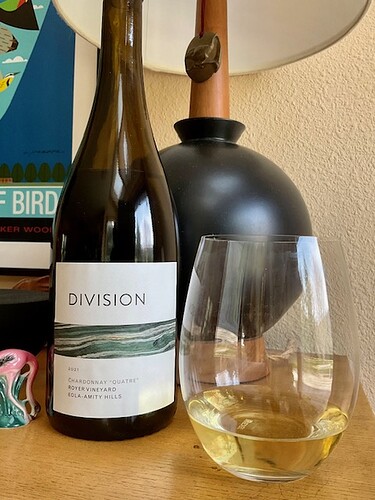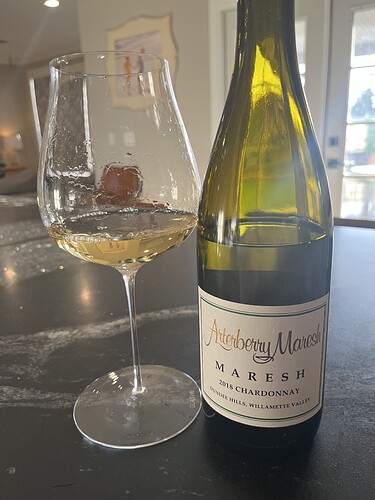This thread prompted me to open a 2018 Martin Woods WV Chardonnay last night. IIRC, this was his first or second vintage making Chardonnay. Less chiseled than his other Chards I’ve tried, which were all 2019s, and no reduction to be found here. Sea spray and lemon with generous fruit and medium acid. An enjoyable entry-level bottle.
Evan made one in 2017 with fruit from Yamhill Valley Vineyards. I have one left that I should probably drink soon.
Thanks for your response, Keith and all the others. I myself harbo some doubts, given how good the Chards from Oregon with which I am already familiar are. Still it would be fun and worthwhile to taste the M. Woods blind with some other faves and see what comes out. If I’m out in Oregon, which I may be this summer, I will have to track you down Keith.
Not painting a very broad brushstroke here, but Martin Woods Chard seem to be an outlier for me. I was just in OR tasting at 6 properties, have tasted more locally before and after the trip, etc. Its not a “good” or “bad” thing, but if you put 4-5 OR Chards in front of me, I am fairly sure I could pick out the Martin Woods one but I couldn’t likely point out the other wine makers if that makes sense. I think it has to do with his distinct use of most local/native wood for barrels so it certainly gives the wine a more unique taste. Again its not a good or bad, I think its just an entity to itself.
I look forward to it!!!
I just went by HiFi Wine Bar and tried all three Martin Woods 2021 Chardonnays - Koosah (high energy, reductive, citrus, lemon, green apple, long finish), Pearlstad (sappy, minerally, saline, great finish), and Yamhill Valley Vineyards (intense, lean, lemon, apple, great finish).
Winemaking was pretty much the same for all the wines - fermented in tank, transferred to and aged in barrel (mixed Oregon & French, 8 yr average age) for 9 to 14 months. I’m not super sensitive to oak, but I didn’t notice any overt oak flavors in these wines. For my palate, all were outstanding, with my favorite being the Koosah, which I would put on par with the Walter Scott version. Then again, I’m a sucker for the reduction…
I ended up buying six of the Koosah, and three each of the other two.
Nice to meet you at HiFi today, Rick. I also favored the Koosah with its abundant energy and pure focus. Cheers!
Good to know about the Martin Woods Chards, will
Have to check them out. I’ve enjoyed their Pinot before and their Gamay is one of my favorites in Oregon.
2014 Walter Scott Cuvee Anne last week was excellent. Not a hint of a hot vintage.
The local Public Broadcasting organization did a story about Chardonnay recently, for a series called Superabundant. Most of the show is about Evan Martin harvesting Chardonnay from Koosah vineyard. Not a lot of new information besides a look at the vineyard and Evan’s winery underneath his house. We did get a nice plug, as Evan was wearing a Heater Allen t-shirt for a good chunk of the show. If I can figure out a link, I’ll post it.
I mentioned above the high praise for Division Wines’ “Quatre” Chardonnay from Royer Vineyard, Eola-Amity Hills/Willamette Valley. Finally snagged 6 bottles and it is delicious. Like a perfect Spring
-to-Summer transition day — a reductive nose, very bright lemon curd, then rich summer stone fruit and tropical notes on the midpalate and finish, but the acid and zing are there to remind you it’s still Springtime. Very nice.
I also bought some, haven’t tried it. looking at the pdx 10 day forecast there will be a mini Spring to Summer transition next week. Perfect time to try one.
Fingers crossed— this is our first year not to have asparagus from the garden before Easter (and we are still waiting). Oh, and that little issue of budbreak — still waiting. I think the latest budbreak in the Willamette Valley (in recent memory at least) is May 1, 2011.
Am I remembering correctly that it’s about 110 days from bud break to harvest for Pinot Noir?
The clock on those sorts of counts starts at flowering, not bud-break (otherwise, our historic average harvest date would be in late July/early August). For what it’s worth, I’ve always heard 100 days, but I suspect the number in the rule of thumb might also have something to do with how ripe people think Pinot Noir should get ![]() .
.
(edited for a typo)
It has been a very cold spring in the PNW, that’s for sure.
Just to add to Saul’s note, to get to the all-important flowering date, we need about 500 growing degree days (GDDs) (or “heat units) after bud break. (GDD in Fahrenheit = ave daily temp (high+low temp/2) minus 50.). And to get to bud break we need a few days at average daily temp 50F (which to flesh out the GDD math, as an example, happens to be 0 GDD). We have been experiencing highs in the mid to high fifties, but lows in the mid thirties (below 0GDD), thus the issue with delayed bud break….
This is what really sets Willamette Valley appart from other areas such as, say, Burgundy. We very frequently get this kind of late start but the good news is that it helps us avoid August/heat when the late ripening stage/harvest of grapes is vulnerable to heat stress. The bad news is that some years the weather is sh*t starting mid-Sept….
But 1999, 2008, 2010, 2011, and 2012 have all worked out well…
…and better, IMO, than some earlier years.
Yep— for sure we can make great wines on these vintages. But on the vineyard side it can be very difficult from what I have heard. For example, that November harvest in 2011 was much reduced due to fungal issues (botrytis, mildew) at some sites (or was it most sites? my sources on this are anecdotal and not extensive…)…

